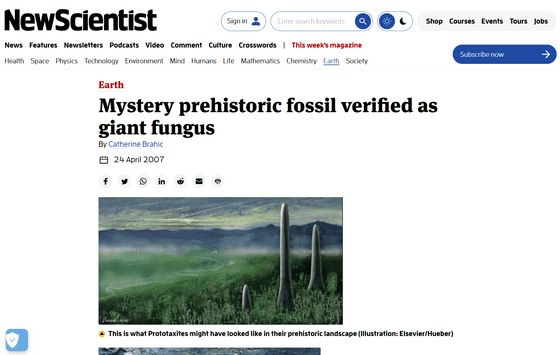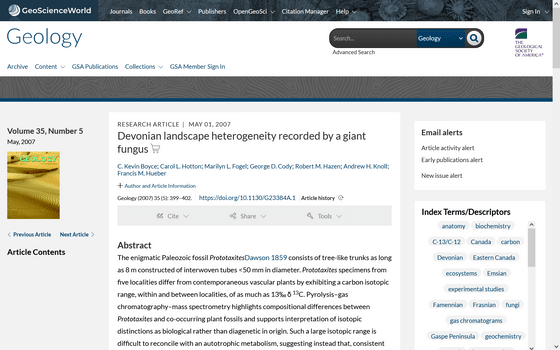The theory that long before trees covered the earth, the earth was covered with giant mushrooms of 8 meters class

A study investigating the global environment about 400 million years ago, when even dinosaurs did not appear, suggested the possibility that the ground was covered with giant fungi.
Long Before Trees Overtook the Land, Earth Was Covered by Giant Mushrooms | Smart News| Smithsonian Magazine

Mystery prehistoric fossil verified as giant fungus | New Scientist
In 1859, a paleontologist in Canada discovered a fossil of a paleontological organism `` Prototaxites '', which is thought to have a trunk of about 8 meters in height and about 1 meter in width. Originally thought to be a type of algae or lichen , several lines of evidence suggest that the fossil is most likely a fungus.

There are many theories about the identity of the Prototaxites fossil, with one scientist saying it was a fungus, another saying it looked like moss, and another saying it was a kind of tree. I showed the idea that The reproduction of the fossil is so large that it is thought to have stood out conspicuously on the earth at that time, when there were only invertebrates and plants of several tens of centimeters in height.
However, in
Devonian landscape heterogeneity recorded by a giant fungus | Geology | GeoScienceWorld
https://doi.org/10.1130/G23384A.1

The researchers who wrote this paper found that the Prototaxites specimens discovered so far, unlike contemporaneous vascular plants, show a wide range of carbon isotope ratios of as much as 13‰ (per mille) within and between localities. pointed out that Pyrolysis-gas chromatography-mass spectrometry revealed differences in the composition of plant fossils from the same period as Prototaxites, and concluded that the isotopic differences could be interpreted as biological.
From this result, such a large isotope ratio difference is unlikely to match the metabolism of

However, this claim has not yet been confirmed, and it seems that it is not yet clear what the giant creatures that ruled the ancient earth really were.
Related Posts:







